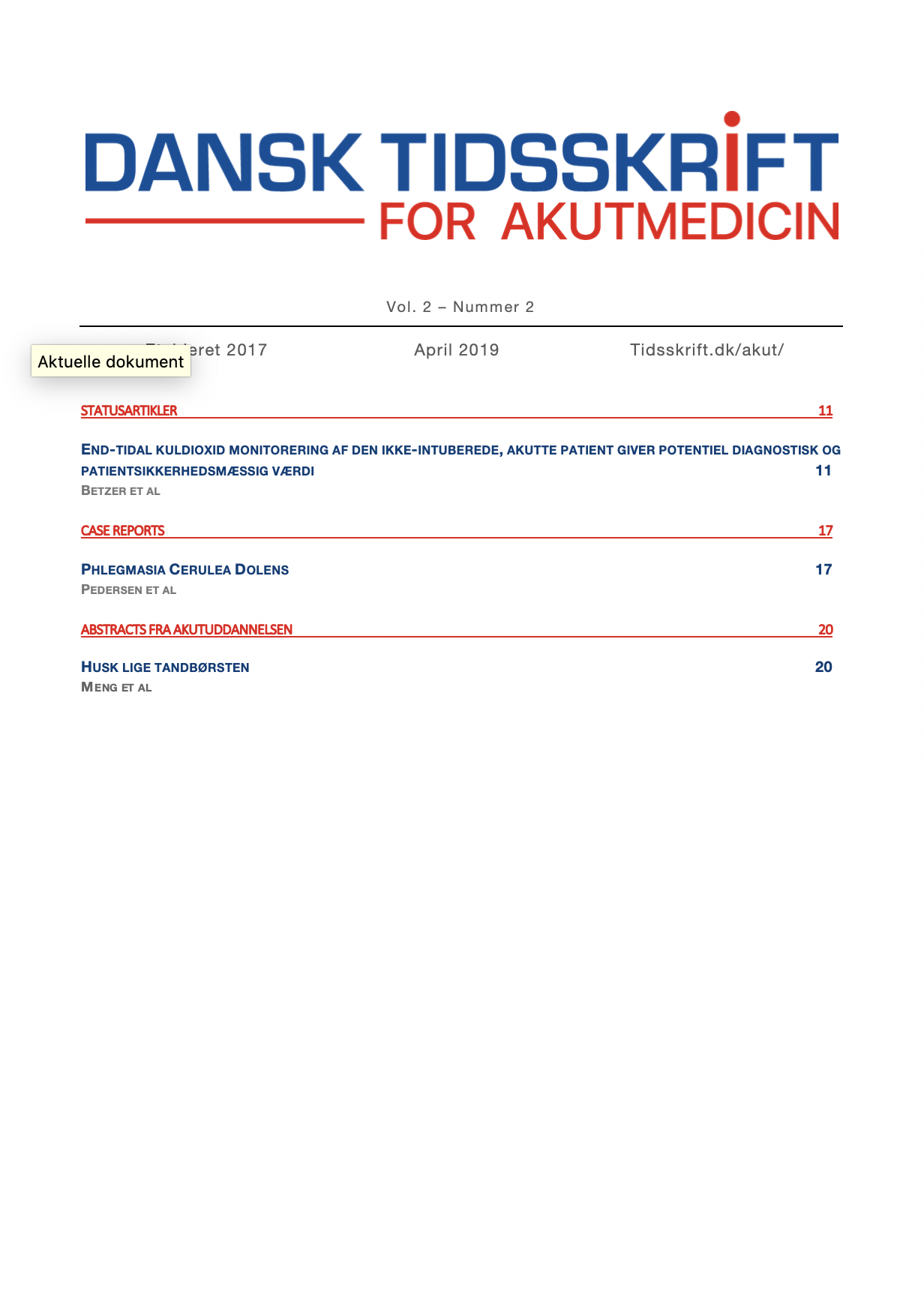Resumé
Baggrund
End-tidal carbondioxid (etCO2) monitorering anvendes rutinemæssigt hos alle intuberede patienter. Kapnografi er ligeledes tilgængelig til den ikke-intuberede, akutte patient, hvor brugen i diagnostisk og patientsikkerhedsmæssigt øjemed er sparsomt beskrevet.
Formål
Formålet med denne statusartikel er at beskrive og diskutere eventuelle diagnostiske og patientsikkerhedsmæssige fordele og ulemper ved kapnografimonitorering af ikke-intuberede, akutte patienter.
Metode
Artiklen er baseret på resultatet af en systematisk litteratursøgning, hvor tilgængelig evidens fra 1990-2016 blev identificeret fra databaserne MEDLINE, Cinahl, Scopus, Cochrane og Academic Search Complete. Litteratur relevant for denne artikels emne blev udvalgt og gennemgået.
Resultat
Artiklen beskriver og diskuterer den udvalgte litteratur. Overordnet vidner denne om en diagnostisk og patientsikkerhedsmæssig fordel ved kapnografi til patienter med vejrtrækningsbesvær, til vurdering af effekt af medicinsk behandling samt til kontinuerlig monitorering. Artiklen diskuterer ligeledes anvendelsen af kapnografi præhospitalt og potentialet for brugen i Akutafdelingen.
Konklusion
Kapnografi findes i varierende grad at have potentiale indenfor diagnostik og kontinuerlig monitorering af akutte patienter, efter adækvat uddannelse i brugen.
_________________________________________________________________________________________________________________________________
Background
End-tidal carbon dioxide (etCO2) monitoring is routinely used in intubated patients. Capnography is also available for the non-intubated patient but its use as a diagnostic and patient safety tool is sparsely described.
Aim
The aim of this article was to describe and discuss potential diagnostic and patient safety benefits of capnography monitoring in acute, non-intubated patients.
Methods
The article is based on the results of a systematic literature search, where available evidence from 1990-2016 was located from the databases MEDLINE, Cinahl, Scopus, Cochrane and Academic Search Complete. Literature relevant for this article was selected and reviewed.
Results
The article describes and discusses the selected literature. Overall, there is evidence of a diagnostic and patient safety benefit for patients with breathing difficulties, assessment of the effect of medical treatment and capnography used as continuous monitoring. The article further discusses the prehospital use of capnography in Denmark and the possible advantages for its use in the Emergency Department.
Conclusions
After adequate training in its use, capnography seems to have potential in diagnostics and continuous monitoring of acute, non-intubated patients.
Referencer
Gravenstein JS, redaktør. Capnography. 2nd ed. Cambridge ; New York: Cambridge University Press; 2011. 474 s. (Cambridge medicine).
Betzer M, Lyngby R. Capnography and clinical decision making in the spontaneously breathing, non-intubated emergency patient - a systematic review. Meeting abstract in Scand J Trauma Resusc Emerg Med. 17. marts 2017;25(2):29. https://doi.org/10.1186/s13049-017-0364-2
Prause G, Hetz H, Lauda P, Pojer H, Smolle-Juettner F, Smolle J. A comparison of the end-tidal-CO2 documented by capnometry and the arterial pCO2 in emergency patients. Resuscitation. oktober 1997;35(2):145–8. https://doi.org/10.1016/S0300-9572(97)00043-9
Vargo JJ, Zuccaro G, Dumot JA, Conwell DL, Morrow JB, Shay SS. Automated graphic assessment of respiratory activity is superior to pulse oximetry and visual assessment for the detection of early respiratory depression during therapeutic upper endoscopy. Gastrointest Endosc. juni 2002;55(7):826–31. https://doi.org/10.1067/mge.2002.124208
Kober A, Schubert B, Bertalanffy P, Gorove L, Puskas T, Gustorff B, m.fl. Capnography in non-tracheally intubated emergency patients as an additional tool in pulse oximetry for prehospital monitoring of respiration. Anesth Analg. januar 2004;98(1):206–10.
Waugh JB, Epps CA, Khodneva YA. Capnography enhances surveillance of respiratory events during procedural sedation: a meta-analysis. J Clin Anesth. maj 2011;23(3):189–96. https://doi.org/10.1016/j.jclinane.2010.08.012
You B, Peslin R, Duvivier C, Vu VD, Grilliat JP. Expiratory capnography in asthma: evaluation of various shape indices. Eur Respir J. 1. februar 1994;7(2):318–23. DOI: 10.1183/09031936.94.0702031318
Howe TA, Jaalam K, Ahmad R, Sheng CK, Nik Ab Rahman NH. The use of end-tidal capnography to monitor non-intubated patients presenting with acute exacerbation of asthma in the emergency department. J Emerg Med. december 2011;41(6):581–9. https://doi.org/10.1016/j.jemermed.2008.10.017
Wahlen BM, Bey T, Wolke BB. Measurement of end-tidal carbon dioxide in spontaneously breathing patients in the pre-hospital setting. A prospective evaluation of 350 patients. Resuscitation. januar 2003;56(1):35–40. DOI: 10.1016/S0300-9572(02)00296-4 ·
Hunter CL, Silvestri S, Ralls G, Papa L. Prehospital end-tidal carbon dioxide differentiates between cardiac and obstructive causes of dyspnoea. Emerg Med J EMJ. juni 2015;32(6):453–6. http://dx.doi.org/10.1136/emermed-2013-203405
Licenseret under en Creative Commons Kreditering 4.0 International-licens (CC BY 4.0).
© Forfatterne.

